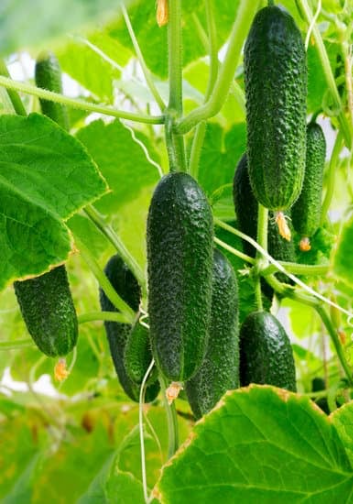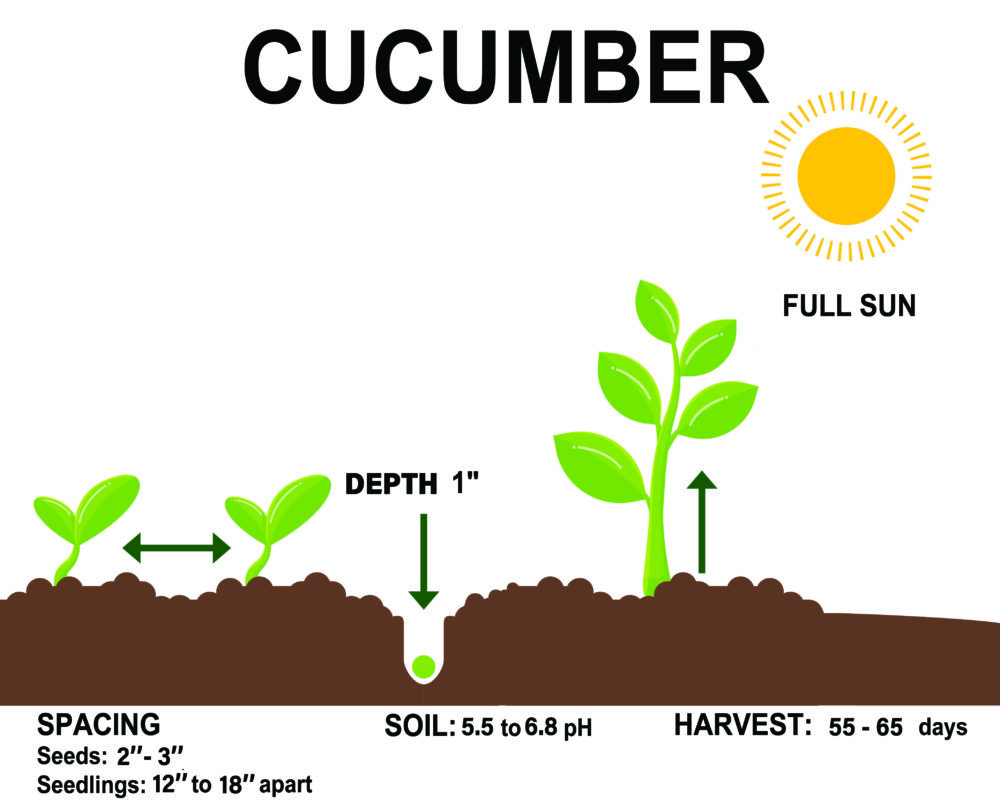Most of us think of cucumbers (Cucumis sativus) as green, seed-filled slices on a salad. Long, green cucumbers are by far the most popular type grown in home gardens, but there are hundreds of cucumber varieties, including round cukes, yellow cukes, skinny English cukes, and exotic Armenian cukes. Cucumbers are relatively easy to grow in many different climates. Homegrown cukes are tastier and crunchier than most store-bought varieties (and they don’t have that thick coating of wax!).
Cucumbers are in the same family as squash and melons. A popular way to categorize cucumbers is to describe them as either slicers or picklers. Both types can be eaten fresh, while pickling cucumbers hold their texture well during processing.
Cucumber leaves are somewhat triangular in shape, with pointed lobes. The texture of the whole plant is rough and prickly. Cucumber flowers are yellow and most commonly monoecious, requiring both male and female blossoms to produce fruits. Newer hybrids are being bred to be parthenocarpic, with only female blossoms that are self-pollinating.
Cucumber fruits can vary in size from 1 or 2 inches long to over a foot. There are also round cucumbers. The outer skin is usually green or yellow and can be either tender or tough. Most varieties are sprinkled with spines, which wipe off easily. Parthenocarpic varieties are seedless.
Cucumbers are planted in spring, after the last frost, and need about 50 to 70 days to produce harvestable fruit.

| Botanical Name | Cucumis sativus |
| Common Names | Cucumber, gherkin |
| Plant Type | Annual |
| Mature Size | 9 to 18 inches tall, 3 to 8 feet wide |
| Sun Exposure | Full sun to partial shade |
| Soil Type | Rich, well-draining |
| Soil pH | Acidic to neutral (5.5 to 7.0) |
| Bloom Time | Seasonal |
| Flower Color | Yellow |
| Hardiness Zones | 4 to 11 (USDA) |
| Native Area | Asia |

When to Plant?
This will be determined by your planting zone. There is a final frost date for each area. As a result, you can plan your gardening activities around this date. Check our Frost Dates Across North America: First & Last Frost Dates Chart. However, the date will not be the same for every plant.
How to Plant
You can sow seeds in the garden about 3 – 4 weeks after the last spring frost.
The ideal soil temperature should be 70°F.
Plant seeds indoors as early as six weeks before transplanting into your garden.
Sow cucumber seeds 1 inch deep.
It is necessary to protect the cucumbers from unexpected frosts and low night temperatures at the beginning of the season.
Cucumbers prefer well-drained soil, rich in organic matter.
To warm up the soil before planting cucumber in spring, you need to cover the bed with black film.
A soil pH of 5.5 to 6.8 provides ideal conditions for cucumbers.

Install a stand or a grate for growing cucumbers to avoid damage and save space. The trellis should be 4 to 6 feet high. Do not let the soil dry out or overwater. It is necessary to maintain even soil moisture. During the summer, give your cucumbers at least 1 inch of water every week. Watering cucumbers should always be at the base. To avoid soil compaction due to abundant watering and slow down the soil water evaporation, mulch around the plants.
How to Cultivate
Water – Cucumbers need between 1 and 2 inches of water per week, depending on the weather and type of soil. The key is to keep the soil slightly moist at all times. Water deeply about once or twice a week – and more often if you’re gardening in sandy soil. A 1- to 3-inch-thick layer of mulch spread between plants helps hold moisture in the soil. Just be sure to leave a space between the mulch and the stems’ base to let moisture escape from the soil.
Soil – 5.5 to 6.8 pH, well-drained, high fertility
Spacing – seeds – 2″ – 3″
Seedling – 12″ – 18″
Seed life: 4 years
Sun: Full sun
Germination: 3 – 10 days, 60°F – 105°F
Day to Harvest: 55 – 65 days
How to Harvest
Cucumbers can be harvested approximately 55 – 65 days after sowing.
Try to check and harvest your cucumbers every day.
Cut the cucumbers from plants with a knife, scissors, or a garden machine.
It is not advisable to twist or pull on the vine. Otherwise, the plant may be damaged.
Hydroponics
Germination: Begin by germinating your cucumber seeds in a suitable growing medium such as rockwool cubes or peat moss pellets. Keep the growing medium moist, and provide warmth and light for successful germination.
pH range: Cucumbers prefer a slightly acidic pH range of 5.5-6.5 in hydroponic systems. Test the pH of your nutrient solution regularly using a pH meter or pH test kit and adjust it as necessary using pH up or pH down solutions.
EC: Cucumbers thrive in nutrient solutions with an electrical conductivity (EC) level of 1.6-2.4 mS/cm. Measure the EC of your nutrient solution using a EC meter and adjust it as necessary by adding or diluting the nutrient solution.
PPM: The total dissolved solids (TDS) or parts per million (PPM) of your nutrient solution should be around 800-2000 PPM for cucumbers. Use a PPM meter to measure the concentration of dissolved solids in your nutrient solution and adjust it by adding or diluting the nutrient solution.
Humidity: Cucumbers prefer a relative humidity (RH) range of 60-70% during the vegetative growth stage and 70-80% during the fruiting stage. Use a hygrometer to measure the RH in your growing area and adjust it by using a humidifier or dehumidifier as necessary.
Light hours: Cucumbers require around 12-16 hours of light per day during the vegetative growth stage and 8-12 hours of light per day during the fruiting stage. Use grow lights such as LED or high-pressure sodium (HPS) lights to provide the necessary light.
Temperature air: The ideal air temperature for cucumbers in hydroponic systems is around 70-80°F (21-27°C) during the day and 60-70°F (15-21°C) at night. Use a thermometer to monitor the air temperature in your growing area and adjust it by using a heater or air conditioner as necessary.
Temperature water: The water temperature for cucumbers in hydroponic systems is around 65-75°F (18-24°C). Use a thermometer to monitor the water temperature in your hydroponic system and adjust it by using a water chiller or heater as necessary.
Follow these guidelines and monitor your plants regularly to ensure they’re healthy and growing well. With a little care and attention, you should be able to grow delicious and healthy cucumbers hydroponically!



